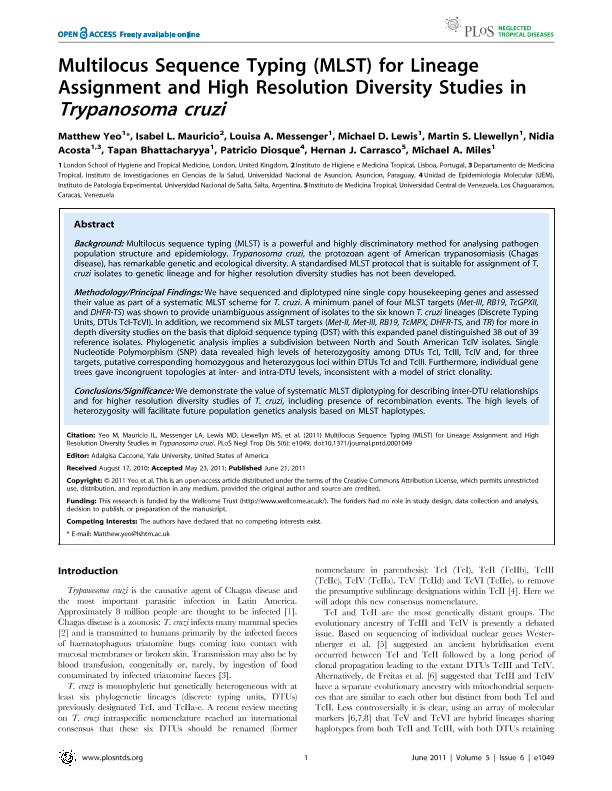Artículo
Multilocus Sequence Typing (MLST) for Lineage Assignment and High Resolution Diversity Studies in Trypanosoma cruzi
Yeo, Matthew; Mauricio, Isabel L.; Messenger, Loisa A.; Lewis, Michael D.; Llewellyn, Martin S.; Acosta, Nidia; Bhattacharyya, Tapan; Diosque, Patricio ; Carrasco, Hernán J.; Miles, Michael A.
; Carrasco, Hernán J.; Miles, Michael A.
 ; Carrasco, Hernán J.; Miles, Michael A.
; Carrasco, Hernán J.; Miles, Michael A.
Fecha de publicación:
21/06/2011
Editorial:
Public Library Of Science
Revista:
Neglected Tropical Diseases
ISSN:
1935-2735
Idioma:
Inglés
Tipo de recurso:
Artículo publicado
Clasificación temática:
Resumen
PLoS Negl Trop Dis. 2011 Jun;5(6):e1049. Epub 2011 Jun 21. Multilocus sequence typing (MLST) for lineage assignment and high resolution diversity studies in Trypanosoma cruzi. Yeo M, Mauricio IL, Messenger LA, Lewis MD, Llewellyn MS, Acosta N, Bhattacharyya T, Diosque P, Carrasco HJ, Miles MA. Source London School of Hygiene and Tropical Medicine, London, United Kingdom. Matthew.yeo@lshtm.ac.uk Abstract BACKGROUND: Multilocus sequence typing (MLST) is a powerful and highly discriminatory method for analysing pathogen population structure and epidemiology. Trypanosoma cruzi, the protozoan agent of American trypanosomiasis (Chagas disease), has remarkable genetic and ecological diversity. A standardised MLST protocol that is suitable for assignment of T. cruzi isolates to genetic lineage and for higher resolution diversity studies has not been developed. METHODOLOGY/PRINCIPAL FINDINGS: We have sequenced and diplotyped nine single copy housekeeping genes and assessed their value as part of a systematic MLST scheme for T. cruzi. A minimum panel of four MLST targets (Met-III, RB19, TcGPXII, and DHFR-TS) was shown to provide unambiguous assignment of isolates to the six known T. cruzi lineages (Discrete Typing Units, DTUs TcI-TcVI). In addition, we recommend six MLST targets (Met-II, Met-III, RB19, TcMPX, DHFR-TS, and TR) for more in depth diversity studies on the basis that diploid sequence typing (DST) with this expanded panel distinguished 38 out of 39 reference isolates. Phylogenetic analysis implies a subdivision between North and South American TcIV isolates. Single Nucleotide Polymorphism (SNP) data revealed high levels of heterozygosity among DTUs TcI, TcIII, TcIV and, for three targets, putative corresponding homozygous and heterozygous loci within DTUs TcI and TcIII. Furthermore, individual gene trees gave incongruent topologies at inter- and intra-DTU levels, inconsistent with a model of strict clonality. CONCLUSIONS/SIGNIFICANCE: We demonstrate the value of systematic MLST diplotyping for describing inter-DTU relationships and for higher resolution diversity studies of T. cruzi, including presence of recombination events. The high levels of heterozygosity will facilitate future population genetics analysis based on MLST haplotypes.
Palabras clave:
Mlst
,
Typing
,
Trypanosoma Cruzi
Archivos asociados
Licencia
Identificadores
Colecciones
Articulos(IPE)
Articulos de INST.DE PATOLOGIA EXPERIMENTAL
Articulos de INST.DE PATOLOGIA EXPERIMENTAL
Citación
Yeo, Matthew; Mauricio, Isabel L.; Messenger, Loisa A.; Lewis, Michael D.; Llewellyn, Martin S.; et al.; Multilocus Sequence Typing (MLST) for Lineage Assignment and High Resolution Diversity Studies in Trypanosoma cruzi; Public Library Of Science; Neglected Tropical Diseases; 5; 6; 21-6-2011; 1049-1049
Compartir
Altmétricas



